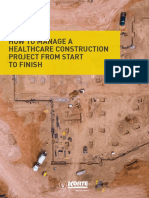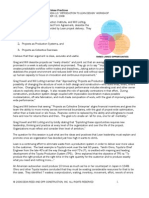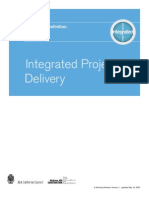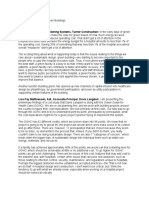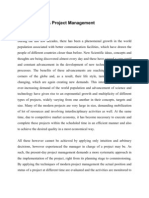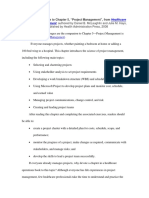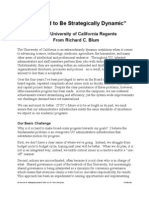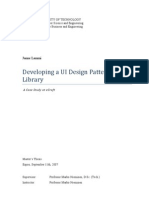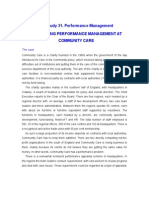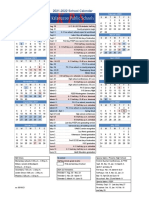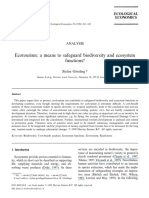Sutter Health: Developing A Contracting Model To Support Lean Project Delivery
Sutter Health: Developing A Contracting Model To Support Lean Project Delivery
Uploaded by
Marcos Camilo SaldiasCopyright:
Available Formats
Sutter Health: Developing A Contracting Model To Support Lean Project Delivery
Sutter Health: Developing A Contracting Model To Support Lean Project Delivery
Uploaded by
Marcos Camilo SaldiasOriginal Title
Copyright
Available Formats
Share this document
Did you find this document useful?
Is this content inappropriate?
Copyright:
Available Formats
Sutter Health: Developing A Contracting Model To Support Lean Project Delivery
Sutter Health: Developing A Contracting Model To Support Lean Project Delivery
Uploaded by
Marcos Camilo SaldiasCopyright:
Available Formats
Sutter Health: Developing a Contracting Model to
Support Lean Project Delivery
William A. Lichtig1
Who is Sutter Health
Sutter Health is a not-for-profit, community based healthcare and hospital system
headquartered in Sacramento, California. The Sutter system serves more than one
hundred communities in Northern California. From its historical roots of being a small
community-based hospital in Sacramento, it has grown to be one of the largest
healthcare providers in Northern California, caring for more patients than any other
network. Its affiliate-based system includes 27 acute care hospitals, over 3,400
physicians, 41,000 employees and recorded over 2.6 million outpatient visits in 2003.
Building Program
In 1994, after the Northridge earthquake caused significant damage to healthcare
facilities in Southern California, the California Legislature enacted SB 1953 – the
Hospital Facilities Seismic Safety Act. In summary, as currently applied, SB 1953
requires significant structural seismic upgrades to be accomplished by January 1, 2013.
In reality, because of the nature of the required improvements, in most cases it is more
cost effective to replace existing facilities, rather than seismically retrofit.
Sutter Health's building program, initially undertaken in response to SB 1953, was
expanded to include a more comprehensive assessment of long-term facility
requirements based upon community needs, community growth and healthcare trends.
In addition to the mandate of SB 1953, Sutter Health made the decision to expand
access to healthcare in the communities it serves by building ambulatory care centers,
cancer treatment facilities, and medical office buildings. Each region developed
proposals to create facilities that would meet the community's healthcare needs and
improve the patient experience.
As currently contemplated, the program includes $5.5 billion of design and construction
to be completed by 2012. This includes acute care facilities permitted by California's
Office of Statewide Health Planning and Development (OSHPD)(where permitting can
take upwards of 20 months), non-acute outpatient facilities (surgery centers), medical
office buildings, parking structures, as well as significant remodels of newer structures
that do not require replacement.
From senior management's perspective, the overall program goal is to successfully
traverse the risks associated with a program of this magnitude, reliably deliver these
projects to their communities, and maintain Sutter Health's superb financial ratings. In
support of these goals, an executive management team composed of Robert Mitsch
(Vice President, Real Estate), David Chambers (Director, Planning, Architecture and
Design), and David Pixley (Director, Project Management and Development) was tasked
with expanding the Facility Planning and Development Department (FPD) to support the
program and put systems in place to manage the task.
1
Mr. Lichtig is an attorney with McDonough, Holland & Allen, P.C. and is Special Counsel to Sutter
Health. He can be reached via e-mail at wlichtig@mhalaw.com.
© Lean Construction Journal 2005 105 www.leanconstructionjournal.org
Vol 2 # 1 April 2005 ISSN: 1555-1369
Lichtig: Sutter Health: Developing a Contracting Model to Support Lean Project Delivery
In developing the necessary systems, FPD focused on increasing the reliability that
projects — including some that would take upwards of five years to design, permit and
construct — would be delivered:
• on time or early
• within budget or less
• without claims
• safely (without creating patients), and
• without burn-out of FPD staff2
In attacking these challenges, FPD developed internal "Standards of Practice,"
standardizing practices that worked well in the past, but also sought to innovate and
adopt new practices to support its goals. As a result, Sutter Health has moved to
implementing Lean Project Delivery.
Move to Lean Project Delivery
The Lean Construction Institute ("LCI") articulated the theory that projects can be
characterized as "stodgy" (simple, certain and slow ) or "dynamic" (complex, uncertain,
and time sensitive). Within these classifications, LCI characterized various systems that
operate within projects: Physics of work (how work gets done), Systems and
Organizations (how the relationship among principal companies is structured), and
Contracts (how the commercial relationship is structured). Historically, LCI and
implementers of the Last Planner System™ have focused on the physics of the work and
attacked the unreliability of project work flow in an effort to reduce project waste.
The question has always remained, to what extent do the other systems operate to
promote or constrain lean project delivery?
With the assistance of Lean Project Consulting, Inc., Sutter Health has developed an
approach which strives to coherently address each level of the project delivery system.
This approach has become known in the community as the Five Big Ideas3. The Five Big
Ideas are summarized in the following graphic:
Figure 1: The Five Big Ideas
The Five Big Ideas form the framework for approaching all aspects of Sutter Health's
Lean Project Delivery. The description that follows is taken from the manifesto that
2
The combined demands of constructing healthcare, education and other public and private facilities
has created a demand for design and construction services that is unprecedented in Northern
California. One challenge facing Sutter Health and other owners will be assuring that its work is
attractive enough for quality contractors and subcontractors in a time of heightened demand. This is
coupled with a growing scarcity of qualified construction trades people to actually perform the field
construction. The problem of a shrinking workforce is not limited to California but is prevalent
throughout the western United States.
3
Adopted by Sutter Health as the foundation of its lean initiative, the Five Big Ideas were developed and
brought to the Sutter Health community by Hal Macomber and Greg Howell.
© Lean Construction Journal 2005 106 www.leanconstructionjournal.org
Vol 2 # 1 April 2005 ISSN: 1555-1369
Lichtig: Sutter Health: Developing a Contracting Model to Support Lean Project Delivery
has been signed by members of FPD and Sutter Health's design and construction
community:
1. Collaborate; really collaborate, throughout design, planning, and execution.
Constructable, maintainable, and affordable design requires the participation
of the range of project performers and constituencies. Since abandoning the
master-builder concept, and separating design from construction, we have been
patching a poorly conceived design practice. Value engineering, design assist,
and constructability reviews mask an underlying assumption — that design can
be successful when separated from engineering and construction. Design is an
iterative conversation; the choice of ends affects means, and available means
affects ends. Collaborative design and planning maximizes positive iterations
and reduces negative iterations.
2. Increase relatedness among all project participants.
People come together on AEC projects as strangers. They too often leave as
enemies. Healthcare facilities projects are complex and long-lived, requiring
ongoing learning, innovation, and collaboration to be successful. The chief
impediment to transforming the design and delivery of capital projects is an
insufficient relatedness of project participants. Participants need to develop
relationships founded on trust if they are to share their mistakes as learning
opportunities for their project, and all the other projects. This will not just
happen. However, we are learning that relationships can be developed
intentionally.
3. Projects are networks of commitments.
Projects are not processes. They are not value streams. The work of
management in project environments is the ongoing articulation and activation
of unique networks of commitment. The work of leaders is bringing coherence
to the network of commitments in the face of the uncertain future and co-
creating the future with project participants. This contrasts with the
commonsense understanding that limits planning as predicting, managing as
controlling, and leadership as setting direction.
4. Optimize the project not the pieces.
Project work is messy. Projects get messier and spin out of control when
contracts and project practices push every activity manager to press for speed
and lowest cost. Pushing for high productivity at the task level may maximize
local performance but it reduces the predictable release of work downstream,
increases project durations, complicates coordination, and reduces trust. In
design, we incur rework and delays. In the field, this means greater danger.
We have a significant opportunity and responsibility to reduce workers'
exposure to hazards on construction projects. Doing so can bring about greater
than 50% improvements in the safety on the work site. As the leading
community-based healthcare system in northern California we are committed to
do all that is possible so that the people who build these projects are able to go
home each night the way they came to work. The way we understand work and
manage planning can increase that messiness or reduce it.
5. Tightly couple action with learning.
Continuous improvement of costs, schedule, and overall project value is
possible when project performers learn in action. Work can be performed in a
way that the performer gets immediate feedback on how well it matched the
intended conditions of satisfaction. Doing work as single-piece flow avoids
producing batches that in some way don't meet customer expectations. The
current separation of planning, execution, and control contributes to poor
project performance and to declining expectations of what is possible.
While the focus of this paper is on the commercial strategies employed by Sutter Health
in moving towards a "relational contracting model," that discussion cannot proceed
without mentioning the other efforts undertaken in support of the initiative.
© Lean Construction Journal 2005 107 www.leanconstructionjournal.org
Vol 2 # 1 April 2005 ISSN: 1555-1369
Lichtig: Sutter Health: Developing a Contracting Model to Support Lean Project Delivery
Sutter Health began by hosting the Sutter Lean Summit, a three-day event held during
March 2004, in Concord, California. The first two days, attended by over 225 members
of FPD and the design and construction community, focused on an introduction to lean
principles structured around the Five Big Ideas. The third day convened company
leaders to discuss the leadership challenges that would emerge during this effort.
The Summit was followed by:
• on-going training for FPD staff, including both formal workshops, weekly
conference calls, and monthly initiatives
• implementation of the Last Planner System™ (LPS) on five projects of differing
size and complexity. Implementation included Sutter Health sponsored two-
day kick-off sessions which trained the project team in the tools of LPS and on-
going project coaching to help the team put the concepts in action.
• a Sutter Health sponsored web-based portal, styled as a "wiki" — a community-
based body of knowledge — for sharing information, tools and experiences.
• members of the design and construction community meeting with FPD staff in
Vendor Forums for facilitated conversations on topics of interest to the
community.
• Sutter Health formed a Lean Executive Leadership Group, a think-tank of
leading industry executives participating in Sutter Health's program, to meet
periodically and share information, successes, and challenges.
Through these efforts, Sutter Health has sought to develop a collective awareness and
understanding of the concepts inherent in Lean Project Delivery, while also building as
sense of community. This has served to provide new foundations for project-based
collaboration and has increased the relatedness of the parties.
Applying Commercial Strategies
Team Selection
Sutter Health continues to look to the Five Big Ideas to inform its commercial strategy,
seeking alignment between the goals of Lean Project Delivery and the commercial terms
of its contracts. Following on its efforts to build a sense of community through the
Sutter Summit and Vendor Forums, Sutter Health looks to build project teams from the
Sutter Health "design and construction community." FPD is focused on forging an
integrated project team, where there are no masters or slaves, but equal participants.
The selection process for Architects and Construction Managers/General Contractors
(CM/GC) is a quality-based evaluation of responses to requests for proposal and follow-
up interviews with short-listed firms. CM/GC selection proceeds immediately after
Architect selection. Major subcontractors are also selected early, typically during the
schematic design phase, to gain maximum participation and innovation when their
efforts are likely to have the greatest financial impact.4
Creating a Collaborative Design Environment
Sutter Health believes that collaboration occurs best when the participants view
themselves as equal participants in the process and when the initial collaboration
centers on exploring and defining the problem, rather than commenting on someone's
proposed solution. Sutter Health expects its design and construction partners to come
to the collaborative meetings from a position of inquiry, rather than advocacy; hoping
to learn something from someone else in the collaborative process that will spur a new
understanding of the problem and a broadened range of possible solutions.
4
Sanvido, Victor E. and Konchar, Mark D. 1999. Selecting Project Delivery Systems: Comparing Design-
Build, Design-Bid-Build and Construction Management at Risk, at p. 51.
© Lean Construction Journal 2005 108 www.leanconstructionjournal.org
Vol 2 # 1 April 2005 ISSN: 1555-1369
Lichtig: Sutter Health: Developing a Contracting Model to Support Lean Project Delivery
In support of these efforts, Sutter Health anticipates that the CM/GC and trades will
have a seat at the table throughout design. It expects that major portions of the
project will garner the participation of design-collaboration or design-build
subcontractors (Mechanical, Electrical, Plumbing, Fire, Curtain wall, skin). Again, the
design process is structured to encourage the sharing of intermediate design documents,
rather than just handing off large batches of drawings at extended intervals.
By involving the constructors early, Sutter Health requests that constructability and
buildability be addressed throughout design, in essence being treated as a design
criteria. Similarly, the team is expected to engage in design reviews with an eye
toward value analysis and value engineering –- constantly exploring whether other
construction options will better serve Sutter Health's value proposition.
While always having required over-the-shoulder pricing to inform design decisions,
Sutter Health has recently moved to experimenting with Target Value Design.5 In
support of the primacy of designing and constructing each project within budget, the
design team accepts significant design-to-budget obligations, which cause the Architect
and CM/GC to collectively focus on the quality of the documents available for pricing
and the quality of the cost modeling that is developed by the CM/GC and its trade
contractors.
Sutter Health also expects that the design and construction team will collectively create
the Conditions of Satisfaction. The parties are expected to develop a joint site/existing
condition investigation plan, proposing the level of investigation that the team
recommends as prudent. In addition, the team jointly develops the scope for third-
party consultants and collectively assess the resulting work product to evaluate it for
completeness and sufficiency to inform design and construction.
Finally, in order to assure that a commercial strategy supporting Lean Project Delivery
is carried through to all levels of the project team, Sutter Health reviews the
subcontract terms to confirm alignment with Sutter Health’s commercial and Lean
Project Delivery policies. Similarly, because traditional project management bonus
terms for CM/GC firms can motivate by local, rather than system-wide, optimization,
Sutter Health’s contract provides that for bonuses to be considered a Cost of the Work,
they must be reviewed and approved by FPD’s project manager. By way of example,
the CM/GC might bonus based upon cash flow, which could cause work to be installed
without regard to the LPS.
Joint Management of Financial Risk
Sutter Health’s contracts attempt to create a system of shared risk, with the goal of
reducing overall project risk, rather than just shifting it. The commercial terms also
call for joint management of the contingency funds available to off-set those risks that
are not eliminated.
As described above, Sutter Health pays for the early involvement of the project team in
an effort to eliminate ambiguity in the documents and maximize the collective
understanding of the project’s conditions of satisfaction. Sutter Health also strives to
raise the quality of design by insisting that design fees be supported by a resource
loaded work plan. CM/GCs are uniformly compensated on a cost-plus fee, guaranteed
maximum price basis, with some subcontractors being cost-plus GMP also. GMP
proposals are generally submitted on drawings submitted for permit, reducing the need
for added contingency.
5
Target Value Design is similar to Target Costing, but may be broadened to encompass additional design
criteria beyond cost, including time, work structuring, buildability, and similar issues. For a discussion
of Target Costing see Ballard, Glenn and Reiser, Paul (2004). The St. Olaf College Fieldhouse Project:
A case Study in Designing to Target Cost. Proceedings of the 12th Annual IGLC Conference.
© Lean Construction Journal 2005 109 www.leanconstructionjournal.org
Vol 2 # 1 April 2005 ISSN: 1555-1369
Lichtig: Sutter Health: Developing a Contracting Model to Support Lean Project Delivery
Sutter Health establishes separate contingency amounts for design development or
estimating, permitting changes, construction, escalation, and overall project
uncertainty. These contingencies are jointly managed throughout design and
construction.
As a result of their early involvement, the CM/GC and trade contractors agree to a
limited basis for change orders — material scope change, changed site conditions, or
unforeseen regulatory or code interpretations. The traditional bases for many change
orders –- lack of document or discipline coordination – are eliminated as a result of the
coordination efforts during the design phase. Because Sutter Health, despite its lean
ideals, does not expect perfection, the Construction Phase Contingency is made
available to address work that was inadvertently omitted from the GMP estimate or
results from coordination mistakes.
Sutter Health has also moved to eliminate the traditional “negligence” standard as the
measure of the designers’ financial responsibility. Instead, Sutter Health negotiates a
deductible as a percentage of construction costs for “errors & omissions,” even those
resulting from negligence, that Sutter will fund out of the design contingency (E&O
Contingency). Above that deductible, the parties negotiate a percentage for which the
designer will be responsible without proof of negligence (“non-negligent cap”). Above
these combined percentages, Sutter must show negligence in order to recover. This
system allows that parties to establish an agreed level of quality and share the risk
without being forced into an adversarial system that creates significant waste. With the
level of quality established, the Architect is able to prepare its resource loaded work
plan accordingly.
Throughout construction, the parties meet regularly to assess reasons for “extra work”
and apportion financial responsibility. The team collectively assesses which of a
number of predefined categories a supposed extra falls within. This collective
assessment allows a full discussion of both the reason for the extra (e.g., design error,
differing site condition or owner scope addition) and financial responsibility in light of
the parties' performance obligations. For example, supposed extra work may be a by-
product of both a design error and the CM/GC's failure to adequately perform its
preconstruction services. In that case, an apportionment would be made between the
Construction Phase Contingency and the E&O Contingency. If the parties are unable to
agree, the issue becomes subject to the dispute resolution process discussed below.
Joint Management of Disputes
Sutter Health seeks to maximize the opportunities for party-controlled dispute
resolution. In addition to the monthly change order review meetings, the contracts
establish an escalating series of dispute resolution meetings. If a dispute is not resolved
through informal negotiations, any party may request that it be elevated to the Project
Manager level. Within 14 days a special meeting is convened at the project site, to be
attended by representatives of Owner, Architect and Contractor.
If the project representatives are unable to resolve the disagreement, it is then
elevated to the Senior Executive level. Here, senior executives from Owner, Architect
and Contractor are to meet face-to-face within 14 days of an impasse being reached at
the project level. The senior executive meeting is expressly for the purpose of
exchanging and reviewing all pertinent documents and information related to the
dispute, freely and candidly discussing each party's position, and "reaching agreement
upon a reasonable compromise resolution of the Claim."
If the dispute is not resolved within seven days of the Senior Executive meeting, the
Owner has the right to appoint an independent expert to review the dispute and issue a
recommendation. The Independent Expert's recommendation is non-binding, but should
© Lean Construction Journal 2005 110 www.leanconstructionjournal.org
Vol 2 # 1 April 2005 ISSN: 1555-1369
Lichtig: Sutter Health: Developing a Contracting Model to Support Lean Project Delivery
help inform the parties' negotiations by providing an informed, objective view of the
facts and circumstances surrounding the dispute.6
If these earlier efforts have been unsuccessful, the agreements call for mandatory
mediation, with the cost to be shared equally by the parties. The mediation must occur
with 30 days, unless all parties agree otherwise. Failing resolution, the parties may
resort to the litigation process, with the prevailing party recovering attorneys' fees and
costs.
These dispute resolution procedures are designed to encourage the parties to freely
share information and negotiate a resolution at the lowest level possible. It is also
sensitive to preserving the on-going relationship between project personnel and
contracting companies, since most project participants are performing on multiple
projects within the system. The goal is to resolve disputes, while preserving the
relationships.
Developing an Incentive Program
Historically, Sutter Health has not used a "shared savings" mechanism, instead having all
project cost savings revert to the owner. A number of Sutter Health's vendors have
requested that it reconsider this position. In assessing whether to implement an
incentive program, Sutter Health has concluded that any such program must be
fashioned to support the Five Big Ideas and balance between the different behaviors
and results called for by those concepts.
From Sutter Health's perspective, the purpose of the incentive program is to encourage
superior performance based upon Sutter Health's goals for Lean Project Delivery and to
reward the design and construction team for successfully achieving superior
performance and successfully exceeding the project expectations and benchmarks. The
program must provide a basis for continually monitoring and reviewing the project
team's performance, providing the team with periodic performance information to allow
corrections or modifications during project performance to improve the quality of the
services provided. Also, the team must participate in the pool so that it supports the
creation of one, unified team focused on overall project performance.
Too often, projects are completed without capturing the learning; "lessons learned" are
discussed at project completion to be applied on the "next" project. One of the Five Big
Ideas is to "Tightly couple learning with action." If periodic project reviews are not
performed, then the opportunity for improvement over the life of a multi-year project
is lost. Moreover, the existence of financial incentives provides added motivation for
individuals and organizations to stretch beyond their current levels of performance or
ways of doing business and may help overcome the inertia and resignation that often
exists on projects.
As preliminarily conceived, the incentive program would be funded with project savings
as evidenced by both contingency preservation and reduction in the project's Costs of
the Work as compared to the amounts contained within the GMP. These savings would
create the "incentive pool" which would then be paid based upon evaluation of
performance against other performance criteria. For example, Sutter Health envisions
that the team would establish performance goals in at least the following areas: cost,
quality, safety, schedule, planning system reliability, innovative design or construction
processes. The team's goals would be expressed as a range of outcomes from "business-
as-usual," to "stretch goals," to "ideal performance." Performance would be monitored
6
Sutter Health has successfully used the Independent Expert procedure to produce a negotiated solution
to a significant design-related claim. The assessment of the Independent Expert helped inform the
Owner's position, resulting in a negotiated settlement and payment in excess of $100,000 to settle a
claim.
© Lean Construction Journal 2005 111 www.leanconstructionjournal.org
Vol 2 # 1 April 2005 ISSN: 1555-1369
Lichtig: Sutter Health: Developing a Contracting Model to Support Lean Project Delivery
and rated, with the overall portion of the incentive pool to be paid to the team based
upon performance on the non-cost performance criteria.
Challenge to Sutter Health's Vendors
Sutter Health has challenged its vendors to learn the skills needed for Lean Project
Delivery. It has also requested that its major vendors develop and share with Sutter
Health their internal implementation strategies, which include strategies to measure
progress along the way. Vendors have been asked to demonstrate a commitment to
continuous improvement and exhibit a willingness to share their learning in the Sutter
Health project community. So far, a number of vendors have met these challenges and
have begun to learn alongside the Sutter Health project management staff.
© Lean Construction Journal 2005 112 www.leanconstructionjournal.org
Vol 2 # 1 April 2005 ISSN: 1555-1369
You might also like
- Hospital Planning and Project ManagementDocument181 pagesHospital Planning and Project ManagementVineet Verma86% (7)
- What Is Infrastructure Project ManagementDocument4 pagesWhat Is Infrastructure Project Managementshagogal100% (1)
- Challenges and Best Practices of Managing Government Projects and ProgramsFrom EverandChallenges and Best Practices of Managing Government Projects and ProgramsNo ratings yet
- Integrated Project Planning and Construction Based on ResultsFrom EverandIntegrated Project Planning and Construction Based on ResultsNo ratings yet
- 2019-2020 Math Observation ReportDocument3 pages2019-2020 Math Observation Reportapi-500978137No ratings yet
- Goat Farming Cost BenefitDocument12 pagesGoat Farming Cost BenefitNadeemNo ratings yet
- Healthcare Construction Start To FinishDocument20 pagesHealthcare Construction Start To Finishsabhay2No ratings yet
- Lean Construction Opportunities Ideas Practices-Deans Speech in Seattle r1Document10 pagesLean Construction Opportunities Ideas Practices-Deans Speech in Seattle r1sheebarayNo ratings yet
- ProjectDocument75 pagesProjectNegash adaneNo ratings yet
- 01 The Lean Project Delivery System An UpdateDocument19 pages01 The Lean Project Delivery System An UpdateWalter Meléndez B.No ratings yet
- The Lean Project Delivery System An UpdateDocument19 pagesThe Lean Project Delivery System An UpdateDavidNo ratings yet
- PMGT2855 Project Acceptance Semester 1 2024 Assignment Response sheetDocument11 pagesPMGT2855 Project Acceptance Semester 1 2024 Assignment Response sheetJoshua ChristopherNo ratings yet
- OAG5323 - Project ManagementDocument21 pagesOAG5323 - Project ManagementWrite ReadNo ratings yet
- Enrichment ActivityDocument5 pagesEnrichment ActivityCristina Aissa SantosNo ratings yet
- IMPJ6078 WISH 2018 Design Healthcare 181026Document42 pagesIMPJ6078 WISH 2018 Design Healthcare 181026jeancsix100% (1)
- ENGG 684 L01 Group 1 Deliverable #2Document15 pagesENGG 684 L01 Group 1 Deliverable #2Hariharan AravindababuNo ratings yet
- Week 14Document6 pagesWeek 14farazkh1311No ratings yet
- Project AppraisalDocument16 pagesProject AppraisalSigei LeonardNo ratings yet
- Theory of Constraints Project Management: A Brief Introduction To The BasicsDocument12 pagesTheory of Constraints Project Management: A Brief Introduction To The BasicsGia Minh Tieu TuNo ratings yet
- Project Governance PDFDocument11 pagesProject Governance PDFLenny RatuvouNo ratings yet
- A Review Paper On To Identify The Various Constraints For Delays in Construction Work and Suggesting Remedial Measures For The SameDocument4 pagesA Review Paper On To Identify The Various Constraints For Delays in Construction Work and Suggesting Remedial Measures For The SameRavindu RansaraNo ratings yet
- PM IntroductionDocument18 pagesPM IntroductionSiddhesh MagdumNo ratings yet
- Full Manual (En)Document13 pagesFull Manual (En)ArunNo ratings yet
- WP Six Steps To Lead IT Transformation 2014Document4 pagesWP Six Steps To Lead IT Transformation 2014burnslNo ratings yet
- 1 s2.0 S1877705817331739 MainDocument15 pages1 s2.0 S1877705817331739 Maintine.torio05No ratings yet
- Solution To Wajenzi DevelopersDocument15 pagesSolution To Wajenzi DevelopersMorio MosoroNo ratings yet
- RefineM-2014-12-Project Management 2014 Year in ReviewDocument4 pagesRefineM-2014-12-Project Management 2014 Year in ReviewRefineM Project Management ConsultingNo ratings yet
- What Is Social Innovation ProjectDocument3 pagesWhat Is Social Innovation ProjectAlthea Noreen MagtibayNo ratings yet
- Integrated Project Delivery: A Working Defi NitionDocument17 pagesIntegrated Project Delivery: A Working Defi NitionrppacittiNo ratings yet
- Business CaseDocument17 pagesBusiness CaseTapasya BhardwajNo ratings yet
- Project ManagementDocument57 pagesProject ManagementMassiwokNo ratings yet
- Crashing of The ProjectDocument4 pagesCrashing of The ProjectApplopediaNo ratings yet
- Cap 1 - Meredith Mantel (2009) Project ManagementDocument34 pagesCap 1 - Meredith Mantel (2009) Project Managementjohn100% (1)
- Pca 6 Ethical CommunitiesDocument4 pagesPca 6 Ethical Communitiesapi-650843806No ratings yet
- NEED For CPMDocument3 pagesNEED For CPMKanasuNo ratings yet
- About Project and Project ManagementDocument9 pagesAbout Project and Project ManagementAbreham BahruNo ratings yet
- GARLAND Project Governance PaperDocument7 pagesGARLAND Project Governance PaperHailu TsegaNo ratings yet
- Project PlaningDocument164 pagesProject PlaningEba Belina GurmuNo ratings yet
- speech for thrusdayDocument9 pagesspeech for thrusdayTasmia Tabassum RahmanNo ratings yet
- Project AppraisalDocument18 pagesProject AppraisalGaurav BundelaNo ratings yet
- Managing construction claims during construction - The proactive approachDocument7 pagesManaging construction claims during construction - The proactive approachWalid Marhaba100% (1)
- Chapter 5 - Linking Text For Companion Website - EditedDocument5 pagesChapter 5 - Linking Text For Companion Website - EditedFreddy VargasNo ratings yet
- Setting The ContextDocument32 pagesSetting The ContextKinetibebNo ratings yet
- Healthcare Project ManagementDocument22 pagesHealthcare Project ManagementMuhammad ZohaibNo ratings yet
- Project ModuleDocument101 pagesProject ModulegebmeleNo ratings yet
- Assignment 1 Project ManagementDocument7 pagesAssignment 1 Project ManagementRihame Khodor HdedeNo ratings yet
- Home Take AssignmentDocument5 pagesHome Take AssignmentKeebeek S Arbas100% (1)
- BOM 7 Activity 1 Project PlantDocument6 pagesBOM 7 Activity 1 Project PlantClinton BernalesNo ratings yet
- Strategically Dynamic BlumDocument7 pagesStrategically Dynamic BlumChris NewfieldNo ratings yet
- WindDocument11 pagesWindKamilNo ratings yet
- What Is Lean Construction? Definition and Principles - ProcoreDocument8 pagesWhat Is Lean Construction? Definition and Principles - ProcoreAtta BediakoNo ratings yet
- IntroducationDocument13 pagesIntroducationPuneet kaurNo ratings yet
- Scope Patrol - ArticleDocument9 pagesScope Patrol - ArticleHeber CalaniNo ratings yet
- Final Infrastructure ReportDocument104 pagesFinal Infrastructure ReportBob StrickleyNo ratings yet
- Insight Article 094 Project GovernanceDocument15 pagesInsight Article 094 Project Governancemancollos kiptoo kiruiNo ratings yet
- Solution Manual For Project Management ADocument15 pagesSolution Manual For Project Management AZamarta Ramazanova100% (1)
- Project Development Evaluation and FeasibilityDocument17 pagesProject Development Evaluation and FeasibilityHamza ZainNo ratings yet
- Trends in Project Management: Reporter #2: ALIGANGA, CHARMAINE MDocument21 pagesTrends in Project Management: Reporter #2: ALIGANGA, CHARMAINE MCharmaine AligangaNo ratings yet
- Project Analysis and Management CH.1 IDRISDocument72 pagesProject Analysis and Management CH.1 IDRISbikilahussenNo ratings yet
- Extra Credit - RakibDocument2 pagesExtra Credit - Rakibrk3840No ratings yet
- Public-Sector Project Management: Meeting the Challenges and Achieving ResultsFrom EverandPublic-Sector Project Management: Meeting the Challenges and Achieving ResultsRating: 3 out of 5 stars3/5 (1)
- Boris Abramovic Master Thesis Hand inDocument89 pagesBoris Abramovic Master Thesis Hand inAgung Eko SutrisnoNo ratings yet
- Grade 4: Daily Lesson LogDocument3 pagesGrade 4: Daily Lesson LogShar Nur JeanNo ratings yet
- Total Quality Management (406) UpdatedDocument4 pagesTotal Quality Management (406) UpdatedHassaan Bin KhalidNo ratings yet
- Asa Briggs 0001Document29 pagesAsa Briggs 0001rafaelfmenezesNo ratings yet
- The Importance of Art AppreciationDocument1 pageThe Importance of Art AppreciationColeen gaboy0% (1)
- Project Planning and AcquisitionDocument14 pagesProject Planning and AcquisitionPrabesh PoudelNo ratings yet
- Https WWW - Shohoz.com Booking Ticket Print QR3MkM4EURyEUQFFjN Print 1Document1 pageHttps WWW - Shohoz.com Booking Ticket Print QR3MkM4EURyEUQFFjN Print 1MH MoinNo ratings yet
- D Example VIT M WO PDFDocument8 pagesD Example VIT M WO PDFMairy PapNo ratings yet
- Thesis 2Document43 pagesThesis 2Jéan SolomonNo ratings yet
- Electives IIDocument20 pagesElectives IIsunit waghmareNo ratings yet
- Airbus X ProcedAirbus X Procedure - and ChecklisDocument3 pagesAirbus X ProcedAirbus X Procedure - and ChecklisbdmppvpyNo ratings yet
- Child Protection and Anti-BullyingDocument9 pagesChild Protection and Anti-BullyingMar IlangosNo ratings yet
- Scholarship Mock Test Marathi Paper 12.5.2021Document4 pagesScholarship Mock Test Marathi Paper 12.5.2021supritaNo ratings yet
- Developing A UI Design Pattern Library - A Case Study at Ecraft (Master's Thesis)Document106 pagesDeveloping A UI Design Pattern Library - A Case Study at Ecraft (Master's Thesis)Janne Lammi100% (2)
- Module 2 - Eco TourismDocument7 pagesModule 2 - Eco TourismChrysmae Acedo50% (2)
- 02 31 Teaching Notes Case Study - Performance ManagementDocument4 pages02 31 Teaching Notes Case Study - Performance ManagementAmna Mubarak67% (3)
- Kalamazoo Public Schools 2021-2022 CalendarDocument1 pageKalamazoo Public Schools 2021-2022 CalendarWWMTNo ratings yet
- Altina The Sword Princess - Volume 14Document203 pagesAltina The Sword Princess - Volume 14Eulises Josué MillánNo ratings yet
- Arts AppreciationDocument44 pagesArts AppreciationChennie Mae Pionan SorianoNo ratings yet
- FitBit Marketing StrategyDocument8 pagesFitBit Marketing StrategyAbhai Pratap SinghNo ratings yet
- London Has World's Worst Traffic Jams 2. You're The GOAT, Not A Goat!Document2 pagesLondon Has World's Worst Traffic Jams 2. You're The GOAT, Not A Goat!Only For DownloadingNo ratings yet
- Letter - ElepanoDocument4 pagesLetter - ElepanorjpogikaayoNo ratings yet
- (Gossling, 1999) Ecotourism, A Means To Safeguard Biodiversity and Ecosystem FunctionsDocument18 pages(Gossling, 1999) Ecotourism, A Means To Safeguard Biodiversity and Ecosystem FunctionsOscar Leonardo Aaron Arizpe VicencioNo ratings yet
- Solution Manual For Project Management A Managerial Approach 9th Edition by Meredith Complete Downloadable File atDocument15 pagesSolution Manual For Project Management A Managerial Approach 9th Edition by Meredith Complete Downloadable File atsujithapothirajNo ratings yet
- Sevan Writers Resort Armenia CMPDocument140 pagesSevan Writers Resort Armenia CMPCHEEKOTI VIVEKNo ratings yet
- Solar Home System in BangladeshDocument18 pagesSolar Home System in Bangladeshsubrata sarkerNo ratings yet
- Elecad Sample ReviewerDocument4 pagesElecad Sample ReviewerRoxanne BagayawaNo ratings yet
- MIS500 Foundations of Information Systems Subject OutlineDocument6 pagesMIS500 Foundations of Information Systems Subject OutlineChan JeffNo ratings yet






